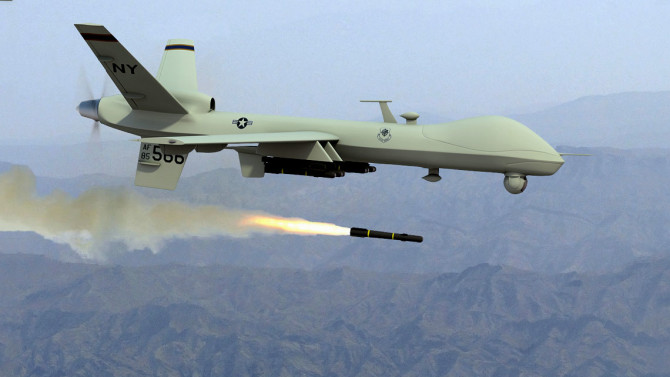Spotlight: U.S. Drones kill excessive number of civilians

A nine-year-old Kenyan girl was leisurely closing up her stall, content after having sold all of her pancakes for the day. Little did she know she would be abruptly killed the next second by a U.S. drone strike, along with several Somali terrorists in the house behind.
This nightmarish scene, from the 2015 feature film “Eye in the Sky,” represents a common real-life scenario for many civilians in countries like Pakistan, Yemen and Somalia.
The Bureau of Investigative Journalism based in London, a non-governmental organization, reported recently that the United States has launched 424 drone strikes in Pakistan alone since 2004, killing 424 to 966 civilians, including about 200 children. According to its calculation, U.S. drones have caused 492 to 1,100 civilian deaths in Pakistan and other countries since 2002.
However, White House politicians appear to be more interested in the political scores than in the “collateral damage,” namely the heavy losses of civilian lives.
UNDERESTIMATED OFFICIAL CASUALTY FIGURE
Drones were developed from a pet project of the Central Intelligence Agency (CIA) into an increasingly strong air power for the United States. They have been employed in several hundred operations in at least nine countries, and are more cost-effective than military actions on the ground, thanks to what Washington calls a capability of “extraordinarily precise targeting.”
For example, U.S. President Barack Obama has taken delight in talking about the recent successful strike on Taliban leader Mullah Akhtar Mansour on May 21.
However, while Americans may value an efficient anti-terror war, the victims and their families certainly don’t feel the same.
Pakistani chauffeur Mohammad Azam, who was killed alongside Mansour in May, left behind a blind mother, a handicapped brother and four children all under 10 to be raised alone by his wife.
The White House recently released data for the first time revealing that between 64 and 116 civilians were killed in 473 U.S. airstrikes, mostly by drones, between 2009 and 2015, in Pakistan, Libya, Yemen, Somalia and North Africa where the United States is not at war, while civilian casualties in Afghanistan, Iraq and Syria were not included in the report.
The figure has drawn serious doubts from many NGOs and think tanks which have been following the United States’ drone strike strategy, saying the number has been severely underestimated.
New York-based Human Rights Watch estimated that at least 57 civilians were killed in seven U.S. drone strikes in Yemen between 2009 and 2013, already half of the maximum casualty figure announced by the U.S. government.
AN EXECUTIONER IN QUESTION
Targets in U.S. drone attacks can be selected merely based on patterns of behavior seen as terrorist activity while their identities remain unknown. Even this standard has given way to some absurd reasons to strike.
In February 2002, the CIA launched a targeted drone strike in Afghanistan, killing three local junk collectors. The reason for the strike was “one of the targets has a similar height as Bin Laden.”
It was estimated that the “signature strikes” accounted for more than two thirds of the drone attacks in Pakistan during Obama’s first term.
“Too often, remotely piloted aircraft are being used as a tool to wantonly kill individuals, rather than as one of many tools to capture and shut down whole terrorist networks,” retired Lieutenant Colonel T. Mark McCurley, a former U.S. Air Force drone pilot, was quoted as saying by a Reuters report in early June.
The attacks violated human rights and international law by failing to discriminate civilians from terrorists, Reiner Braun, co-president of the International Peace Bureau, one of the world’s oldest international peace federations, told Xinhua.
The drone strikes serve as judges and executioners at the same time, Braun added.
Former drone pilot Brandon Bryant warned that by using drones to fight terrorism, the United States might actually foster more terrorism, as family members or friends of the collateral damage might want revenge and become potential terrorists.
Xinhua